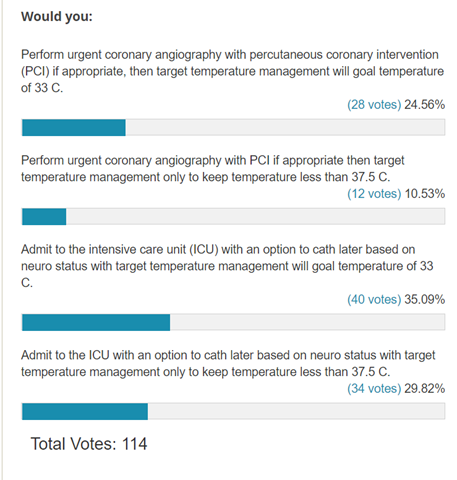Poll Results: NSTEMI and Cardiac Arrest Treatment
In our recent poll, we asked 114 respondents how they would manage a patient who came in with cardiac arrest and non-ST-elevation myocardial infarction (NSTEMI). Approximately 2/3 indicated they would choose delayed angiography dependent on the patient's subsequent neurologic status, with 36% opting for immediate angiography. Goal temperature for management was relatively evenly split, with 60% opting for a goal temperature of 33°C while 40% had a goal temperature <37.5°C.

The TOMAHAWK trial is the most recent randomized trial to test whether routine immediate coronary angiography (possibly followed by revascularization) is superior to a deferred approach in resuscitated patients with out-of-hospital cardiac arrest without ST-segment elevation.1 In this trial, there was no benefit of an immediate compared to a delayed strategy for 30-day risk of all-cause mortality. The current findings are consistent with the results of the randomized COACT trial, which also showed no significant differences in clinical outcome among patients with out-of-hospital cardiac arrest between immediate and delayed coronary angiography at 90 days and at 1 year.2 Other randomized trials are ongoing; until their results are reported, routine immediate coronary angiography in resuscitated patients with out-of-hospital cardiac arrest without STEMI does not appear indicated.
Until recently, targeted temperature management was strongly recommended for neuroprotection in patients who remain comatose after resuscitation from a cardiac arrest. However, this recommendation is based on data from earlier trials that had many limitations.3,4 Both trials were small, temperature was not actively managed in the control arm making it unclear if benefits were due to a true benefit of therapeutic hypothermia (TH) or due to the harmful effects of fever in the normothermia group. In an effort to address these limitations, The Targeted Temperature Management (TTM) trial tested two different temperature targets: 33°C versus 36°C, with active temperature management in both groups;5 they found no significant difference in the composite of mortality and poor neurological outcome at 6 months. More recently, the TTM2 trial randomized patients to TH of 33°C versus targeted normothermia (goal temperature: <37.5°C).6 Again, there was no difference in overall survival or survival with severe disability. Some limitations may have affected the results. More than 90% of cardiac arrests were witnessed and approximately 80% received bystander cardiopulmonary resuscitation (CPR), with a high proportion of an initial shockable rhythm, active cooling was actually required in 46% of patients in the normothermia group to control fever, and the total time from patient contact to temperature goal took over 5 hours. Whether earlier, more rapid cooling will result in improved neuroprotection and is a goal of ongoing randomized trials.
References
- Desch S, Freund A, Akin I, et al. Angiography after out-of-hospital cardiac arrest without ST-segment elevation. N Engl J Med 2021;Aug 29:[Epub ahead of print].
- Lemkes JS, Janssens GN, van der Hoeven NW, et al. Coronary angiography after cardiac arrest without ST-segment elevation. N Engl J Med 2019;380:1397-1407.
- Hypothermia after Cardiac Arrest Study Group. Mild therapeutic hypothermia to improve the neurologic outcome after cardiac arrest. N Engl J Med 2002;346:549-56.
- Bernard SA, Gray TW, Buist MD, et al. Treatment of comatose survivors of out-of-hospital cardiac arrest with induced hypothermia. N Engl J Med 2002;346:557-63.
- Nielsen N, Wetterslev J, Cronberg T, et al. Targeted temperature management at 33 degrees C versus 36 degrees C after cardiac arrest. N Engl J Med 2013;369:2197-2206.
- Lascarrou JB, Merdji H, Le Gouge A, et al. Targeted temperature management for cardiac arrest with nonshockable rhythm. N Engl J Med 2019;381:2327-37.
Clinical Topics: Arrhythmias and Clinical EP, Cardiovascular Care Team, Invasive Cardiovascular Angiography and Intervention, Noninvasive Imaging, Stable Ischemic Heart Disease, Vascular Medicine, SCD/Ventricular Arrhythmias, Interventions and Imaging, Interventions and Vascular Medicine, Angiography, Nuclear Imaging, Chronic Angina, Acute Coronary Syndromes
Keywords: Non-ST Elevated Myocardial Infarction, Out-of-Hospital Cardiac Arrest, Coronary Angiography, Neuroprotection, ST Elevation Myocardial Infarction, Temperature, Cardiopulmonary Resuscitation, Hypothermia, Induced, Surveys and Questionnaires
< Back to Listings
